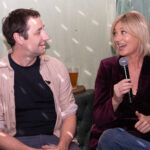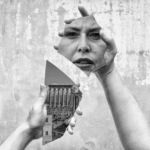With the Voice to Parliament referendum just days away, early voting centres are busier than usual with those trying to avoid the big rush on Saturday.
And these public hotspots have become places of friendly rivalry between the Yes and No camps, despite an official government warning issued nationwide to “protect the peace”.
Down at Concord Community Centre in Sydney’s Inner West, voters from the Reid and Waterloo electorate have been trickling in to meet a cardboard barricade of campaigners for and against the proposed amendment to the Constitution.
Notably, Reid’s own electoral member, Labor’s Sally Sitou, fronted one Yes team. Leading with the positives, she described the proposed Voice to Parliament as “just like the SRC (student representative council) at school, that provides advice to the principal”.

Sally Sitou, Labor MP for Reid, campaigning for a Yes vote at Concord Community Centre.
Sitou is clear politics are not the aim of this election, saying it’s a “grassroots campaign” for our Indigenous Australians.
Yet the No campaigners beg to differ. Sitting down with Concord resident and No campaigner Serge, we watched a small squabble break out when volunteers started replacing campaign posters.
“Bit of rivalry here,” Serge joked.
Speaking to him and other No campaigners off the record, a common reason for voting No was the belief there are other ways to help Indigenous Australians and that the Voice would divide, rather than unify, Australians.
“We’ve already got 11 voices in parliament, from every colour and party you want to have,” said Serge. “They’ve got to be more effective than a Voice to Parliament.”

Serge, a prominent campaigner and vocal supporter of the No vote.
Indigenous Liberal MP Jacinta Price’s name kept cropping up. As the most high-profile Indigenous spokesperson for the No campaign, Serge and other No voters stressed the importance of her Indigenous experience in contributing to support for the No vote.
The Yes campaigners, meanwhile, remain adamant they can still pull out a win, although it’s clear the current lead of the No vote is taking a toll on all volunteers.
“It’s quite disheartening, the division that [the No campaign] is causing,” said Yes campaigner Felicity.

Felicity, one of the Yes campaigners in Reid.
Just looking around the front of the community centre, the difference of Yes and No is literally black and white – if you’re looking at T-shirts.
Both Felicity and Greg, another volunteer, criticised the role of social media, and the “Murdoch press”, as a “platform of miscommunication” for conservative voters.
“Unfortunately, the No campaign has been more efficient than the Yes campaign in realising the power of misinformation,” said Greg.

Greg, a Yes campaigner in the classic YES23 shirt.
Indigenous Australians make up about 0.6 per cent of Reid’s population – a small fraction of the voting population. And the demographic of early voters has reflected the older and arguably higher socioeconomic backgrounds of Reid – coming from suburbs like Concord and Cabarita, where median house prices exceed $2 million.
It’s no surprise No campaigners feel confident in this demographically older and more conservative part of the Inner West.
As Serge said: “The older generation… they understand. They don’t want Australia divided.”
The narrative in this small part of Sydney, from talking with both sides, seems to come down to “us” and “them” – where Indigenous people, as Sally Sitou puts it “[are] the ones who asked for this… and what we are doing, what I am doing, is supporting that.”
The referendum for an Indigenous Voice to Parliament will be held this Saturday, October 14. Early voting centres remain open until then.
Main image by Kyara Meegamuge.




























